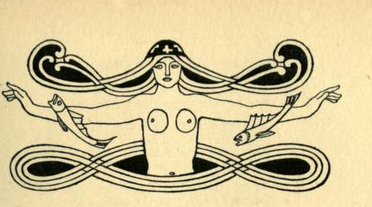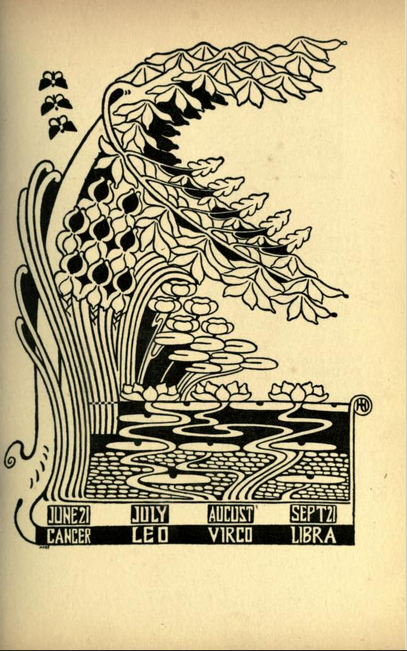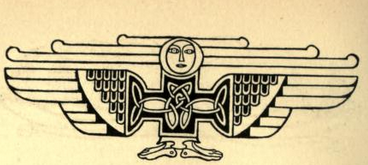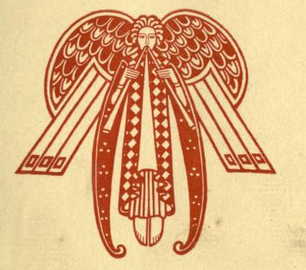CRITICAL INTRODUCTION
THE EVERGREEN: A NORTHERN SEASONAL
VOLUME 3: SUMMER 1896

Volume 3 of The Evergreen: A Northern Seasonal came out in the third week of June, nine months after the previous issue. While the Autumn number had focused on the harmonious cooperation of people living in cities, nations, and the world, the Summer number concentrated on the Celtic elements of song, sea, sex, and sainthood. The contents are dominated by art and poetry, with twelve full-page pictures and fourteen poems—fifteen, if John Duncan’s verse accompanying his “Surface Water” drawing is included—the largest number to date. The Summer number also featured more women contributors than previous issues: a total of ten, with five writers (counting Fiona Macleod) and five artists (although these were restricted to decoration, rather than full-page artwork). In an issue that included an essay by the authors of The Evolution of Sex (1889) analyzing the roles of women workers in apian life and human civilization, it might have seemed politic to include at least a handful of female contributors ([Geddes and Thomson]). While many of the volume’s contributors had previously published in The Evergreen, the Summer issue also introduced H. Bellyse Baildon, George Eyre-Todd, Philip Perceval Graves, Jane Hay, Nora Hopper, Douglas Hyde, and W. J. Robertson in its literary contents, as well as artists Robert Brough and Andrew Kay Womrath. This issue had only one French piece, by Abbé Félix Klein, whose essay was, once again, published in the Season in the World section.

In the absence of a prefatory note of any kind, Helen Hay’s Almanac for 21 June through 21 September introduces the dominant themes of the Summer number (5). The bold black-and-white design visually expresses the issue’s central idea that summer is the season of greatest intensity: “unconscious plant-life is crowned in the flowers,” as J. Arthur Thomson writes in “The Biology of Summer,” and yet “the vigorous intensity of life is interrupted by sleep, weariness, and death” (19). Thomson argues that this is why “the Biology of Summer” has for its central problem—the influence of heat and light upon life” (20). Hay’s Almanac introduces this theme with water imagery, offering an elemental solution to the season’s basic problematic. In compositional stages moving upwards from the riverbed, through the roots of water lilies, to the surface of plants, to a sky where three descending butterflies mark the variations of change, transition, and death, Hay demarcates summer’s intense, ephemeral, growth. This remarkable design, with its striking disposition of positive and negative space and combination of curvilinear lines with geometric pattern, shows Hay’s mastery of Celtic illumination for the modern age.
Hay’s response to the season’s problem “of heat and light upon life” with water imagery becomes a leitmotif that continues throughout the volume’s artistic and literary contents. Among the full-page illustrations, Robert Burns’s “Bathers,” John Duncan’s “Surface Water,” W. G. Burn Murdoch’s “Antarctic Summer,” and Andrew Kay Womrath’s “La Lune d’Été” incorporate rivers, ponds, oceans, and seashores in their compositions. Notably, many of the volume’s ornaments also integrate water themes in their Celtic-inspired designs, beginning with John Duncan’s headpiece featuring a stylized mermaid framed by flying fish for Rosa Mulholland’s “Forerunner” (11). Duncan’s motif recalls Edward Burne-Jones’s painting The Sea Nymph, reproduced in the first volume of The Pageant the same year, highlighting a fin-de-siècle fascination with feminine monsters of the sea. Annie Mackie created an intricate tailpiece of a fish swallowing another sea creature for Fiona Macleod’s “A Summer Air” (105), while Marion A. Mason designed a crab tailpiece for John Macleay’s “Nannack” (134). Mason also designed mirroring mermen seated in scallop shells as the headpiece for George Eyre-Todd’s “Night in Arran” (137), which pairs well with Nellie Baxter’s tailpiece for Macleod’s “Under the Rowans” on the facing page (136). The Contents page of the Summer issue reverts to the practice of the first, Spring number, and gives credit by name and page number for each ornament designed by Baxter, Duncan, Hay, Mackie, and Mason (5).

The Celtic-inspired ornaments—so important to both the architecture of The Evergreen and its publishers’ larger plans for a Renascence in Old Town Edinburgh— are more accomplished and varied in the Summer volume than the previous two issues. John Duncan and Helen Hay, in particular, design modern-looking adaptations of Celtic illuminations. Hay’s headpiece for Baildon’s tribute sonnet “To Robert Burns—(1759-1796)” combines botanical, anthropomorphic, and geometric designs in a way both Celtic-inspired and utterly original (120). Duncan’s headpiece for Edith Wingate Rinder’s “Telen Rumengol,” or “The Harp of Rumengol,” is a Nabi-like design of a winged creature built on the form of a Celtic cross (90). The cross and its quadrants formed a central, mystic, symbol in the Theosophist-inspired decorative art of the French Nabi group, which included Evergreen contributor Paul Sérusier and influenced the Ramsay Garden mural makers (Mauner 101; Willsdon 88). Duncan’s anthropomorphic head- and tailpieces for “Summer-Night Sadness,” a poem by W. J. Robertson meditating on death as a return to nature’s cycles, are deliberately elemental in their combination of line and geometric pattern (101 and 103). Duncan’s ornaments introduce a spiritual or mystical element to the Evergreen’s pages, starting with the title-page decoration, which features a stylized angel playing pipes printed in red-brown ink (3). His headpiece depicting St. Patrick quelling the snakes provides an apt decoration for Fiona Macleod’s Celtic legend, “The Kingdom of the Earth” (120). The sequence of head- and tailpieces decorating each literary item interlace the pages of the magazine with an ornamental tracery that binds and integrates them.

The coherence of design in the Summer issue shows the development of skill and understanding of ornamentation by the Evergreen designers since the Spring issue of 1895. While the first number included a number of textual decorations with little relationship to the traditional practices of Celtic illumination, and even had what appear to be some of Constable’s stock printing devices, the third volume featured only purpose-made ornaments by local designers, each developing their own modern style from Celtic tradition. All trained by Duncan, these extraordinary women designers—Baxter, Hay, Mackie, and Mason—deserve to be better known. As Clara Young observes, to viewers today, the strength of The Evergreen lies “in the sheer artistry and exquisite visual presentation—due in great part to the artworks and the astonishingly decorative and varied head-pieces and tail-pieces created by Duncan himself and his four young ladies. Designs that were described as ‘after the manner of Celtic Ornament’ now appear to us to be totally suffused with the international style of the moment—Art Nouveau” (74). Young’s positive assessment has only developed with the distance of history. Contemporary reviewers did not, in general, appreciate the artwork in the Evergreen. As the Saturday Reviewer put it: “It is all very well to be elemental—artists may be anything they like so long as they succeed—but meaningless designs are meaningless the world over” (“Reviews and Magazines” 48).
The literary contents explore the general problem of the season as set out in Thomson’s “Biology of Summer”: the intensity of heat and light, the fecundity and activity of the biological and zoological world, and the ongoing awareness of weariness and death. Like the visual materials, the verbal texts often draw on water and sun as fundamental elements of setting and symbol. Meaning emerges from the sea-locked locations of islands in Jane Hay’s “The Dance of Life” and George Eyre-Todd’s “Night in Arran,” both prose pieces. Amongst the poetic contents, William Sharp’s “Oceanus,” Robertson’s “Summer-Night Sadness,” and Macleod’s “Summer Air” all draw on water symbolism. Seasonal intensity and ephemerality are captured in the theme of love, reproduction, and loss in such poems as Douglas’s “Song,” Macleod’s “Under the Rowans,” and the pseudonymous Vita’s “The Unborn,” as well as in John Macleay’s Kailyard-style, sentimental Scots story, “Nannack.”
If the Autumn issue emphasized the old Franco-Scottish bonds, the Summer number developed its Pan-Celtic connections, particularly with Brittany and Ireland. As Megan Ferguson observes, “the cross-pollination of ideas and issues” across Celtic nations was active at this time, and the Evergreen played an important role in their dissemination (172). Among the Irish writers, Nora Hopper, Douglas Hyde, Rosa Mulholland, and Philip Perceval Graves contributed poems inspired by Celtic story and legend. The first president of the Gaelic League, Hyde drew on both oral tradition and manuscripts in his extensive publications (Connolly). His contribution to the Evergreen, “From the Irish Gaelic of Tadhg Gaolach o Suilliobháin,” included three long stanzas translated from their original Irish. Graves’s verses celebrated Cuculain [sic], the Celtic hero whose feats were also “awakened” in John Duncan’s mural on the subject at Ramsay Garden (Ferguson 91). Both Mullholland’s two “Songs” and Hopper’s “Swan-White” personify the season as elemental female figures. Edith Wingate Rinder’s “Telen Rumengol” bring the Celtic revival and the seasonal theme together with an adaptation of Breton writer Anatole Le Braz’s retelling of the traditional Celtic tale of the “Summer Pardon.” In “The Kingdom of the Earth”, a legend about the meeting of the the Gypsy King (“Deep Knowledge”) and the infant Jesus (“King of the Elements”), Rinder’s “The Kingdom of the Earth” celebrates the mystical braiding of pagan and Christian traditions.
Rinder and Macleod both published their legendary material in Patrick Geddes and Colleagues’s Celtic Library series, which Sharp edited. Macleod’s “Kingdom of the Earth” was taken from one of her books for this imprint, The Washer of the Ford, published only a month before the Summer issue of the Evergreen came out. Lyra Celtica: An Anthology of Representative Celtic Poetry, was also published by Geddes & Colleagues in 1896. Edited by Elizabeth Sharp (William’s wife), Lyra Celtica included work by Evergreen poets Hopper, Hyde, Macdonald, Macfie, Macleod, Mulholland, and Paton. Thus, in addition to disseminating Celtic art and story, The Evergreen: A Northern Seasonal also functioned as a promotional vehicle for the books published by Geddes & Colleagues, just as The Yellow Book prominently featured the artists and authors on John Lane’s publishing list for The Bodley Head.
Despite the quality of the literary and artistic contributions, and the integrated design of the Summer number, the issue did not fare well with critics. The Saturday Review contemptuously dismissed The Evergreen’s third volume: “The all-embracing garment stitched together from shreds of Buddhism, the workshop of Pan, with here a patch of Chivalry, there a frill of Ruskin, or a bit of the New Woman, or anything else that lies handy, this is too large a thing for the wearing of Mr. Patrick Geddes and his colleagues of the Lawnmarket” (“Reviews and Magazines,” 48). The critic’s description seems particularly motivated by the essays of Thomson and Geddes, which were influenced by current Theosophist trends toward blending eastern religion with western science (Johnson). In his “Biology of Summer,” Thomson argues that “no one can have realized what the work of Summer actually means, without feeling the profound truth of the Buddhist doctrine of reincarnation” (26), while Geddes’s “Flower in the Grass” considers the influence of the east on the west in the traditions of the pastoral and the patriarch. The co-authored “Moral Evolution of Sex” continues the essentialist ideas put forward in “Flower in the Grass” to suggest that medieval chivalry described an ideal relationship between the sexes because “each sex not only expresses its own quality, its own superiority over the other, but uses this to develop the other” ([Geddes and Thomson] 80). Despite gestures toward equality, such ideas are closer to those of John Ruskin than to those of fin-de-siècle New Women.
Although spread out over two sections—Summer in Nature and Summer in Life—these three essays, combined, take up nearly half the page count of the volume and must have influenced reader reception generally. The assumptions of compulsory heterosexuality and essentialism underlying Thomson and Geddes’s writings might even have influenced Evergreen contributors. Rosa Mulholland’s “The Meeting of Summer and Spring,” for example, personifies both seasons as beautiful women. The closing image of her poem offers a scene of erotic intimacy reminiscent of Christina Rossetti’s “Goblin Market,” where Lizzie and Laura sleep together “Golden head by golden head,/ Like two pigeons in one nest” (lines 184-185). Famously pictured in the title-page vignette for the poem by the artist’s brother, the image was part of fin-de-siècle visual discourse, and would have been well known to the Evergreen’s readers.

Mullholland’s final stanza reads:
Asleep upon the rosy breast
Of Summer, Spring is there
Kissed into her long swoon of rest
And couched in hiding where
Winter will find her in her nest
One day, and waken her. (“Song,” 15)
This promise of a sexual awakening may have whetted readers’ appetites for the upcoming Winter number, the fourth and last volume of The Evergreen: A Northern Seasonal.
©2018 Lorraine Janzen Kooistra, Ryerson University Centre for Digital Humanities
Works Cited
- Baildon, H. Bellyse. “To Robert Burns—(1759-1786).” The Evergreen: A Northern Seasonal, vol. 3, Summer 1896, p. 119. Yellow Nineties 2.0, edited by Lorraine Janzen Kooistra, Ryerson University Centre for Digital Humanities, 2018. https://beta.1890s.ca/egv3_baildon_burns/
- Baxter, Nellie. Tailpiece for “Under the Rowans.” The Evergreen: A Northern Seasonal, vol. 3, Summer 1896, p. 136. Yellow Nineties 2.0, edited by Lorraine Janzen Kooistra, Ryerson University Centre for Digital Humanities, 2018. https://ornament.library.ryerson.ca/files/show/250
- Burne-Jones, Sir Edward. “The Sea Nymph,” The Pageant, vol 1, 1896, p 173. Yellow Nineties 2.0, edited by Lorraine Janzen Kooistra, Ryerson University Centre for Digital Humanities, 2020. https://beta.1890s.ca/pageant_volumes/
- Burn-Murdoch, W. G. “Antarctic Summer.” The Evergreen: A Northern Seasonal, vol. 3, Summer 1896, p. 39. Yellow Nineties 2.0, edited by Lorraine Janzen Kooistra, Ryerson University Centre for Digital Humanities, 2018. https://beta.1890s.ca/egv3_murdoch_antarctic/
- Burns, Robert. “Bathers.” The Evergreen: A Northern Seasonal, vol. 3, Summer 1896, p. 17. Yellow Nineties 2.0, edited by Lorraine Janzen Kooistra, Ryerson University Centre for Digital Humanities, 2018. https://beta.1890s.ca/egv3_burns_bathers/
- Connolly, S. J. “Douglas Hyde (1860-1949),” Oxford Companion to Irish History, 2nd edition, Oxford University Press 2007. Oxford Reference Online.
- “Contents.” The Evergreen: A Northern Seasonal, vol. 3, Summer 1896, pp. 4-5. Yellow Nineties 2.0, edited by Lorraine Janzen Kooistra, Ryerson University Centre for Digital Humanities, 2018. https://beta.1890s.ca/egv3_toc/
- Duncan, John. Headpiece for “A Forerunner.” The Evergreen: A Northern Seasonal, vol. 3, Summer 1896, p. 11. Yellow Nineties 2.0, edited by Lorraine Janzen Kooistra, Ryerson University Centre for Digital Humanities, 2018. https://ornament.library.ryerson.ca/files/show/183
- —. Headpiece for “The Kingdom of the Earth.” The Evergreen: A Northern Seasonal, vol. 3, Summer 1896, p. 120. Yellow Nineties 2.0, edited by Lorraine Janzen Kooistra, Ryerson University Centre for Digital Humanities, 2018. https://ornament.library.ryerson.ca/files/show/236
- —. Headpiece for “Summer-Night Sadness.” The Evergreen: A Northern Seasonal, vol. 3, Summer 1896, p. 101. Yellow Nineties 2.0, edited by Lorraine Janzen Kooistra, Ryerson University Centre for Digital Humanities, 2018. http://ornament.library.ryerson.ca/items/show/78
- —. Tailpiece for “Summer-Night Sadness.” The Evergreen: A Northern Seasonal, vol. 3, Summer 1896, p. 103. Yellow Nineties 2.0, edited by Lorraine Janzen Kooistra, Ryerson University Centre for Digital Humanities, 2018. http://ornament.library.ryerson.ca/items/show/78
- —. “Surface Water.” The Evergreen: A Northern Seasonal, vol. 3, Summer 1896, pp. 28-29. Yellow Nineties 2.0, edited by Lorraine Janzen Kooistra, Ryerson University Centre for Digital Humanities, 2018. https://beta.1890s.ca/egv3_duncan_surface/
- Eyre-Todd, George. “Night in Arran.” The Evergreen: A Northern Seasonal, vol. 3, Summer 1896, pp. 137-141. Yellow Nineties 2.0, edited by Lorraine Janzen Kooistra, Ryerson University Centre for Digital Humanities, 2018. https://beta.1890s.ca/egv3_eyre-todd_arran/
- Ferguson, Megan C. “Patrick Geddes and the Celtic Renascence of the 1890s,” Doctoral Dissertation, University of Dundee, 2011. https://core.ac.uk/download/pdf/20479214.pdf
- Geddes, Patrick. “Flower in the Grass.” The Evergreen: A Northern Seasonal, vol. 3, Summer 1896, pp. 43-63. Yellow Nineties 2.0, edited by Lorraine Janzen Kooistra, Ryerson University Centre for Digital Humanities, 2018. https://beta.1890s.ca/egv3_geddes_flower/
- [Geddes, Patrick, and J. Arthur Thomson]. “The Moral Evolution of Sex.” The Evergreen: A Northern Seasonal, vol. 3, Summer 1896, pp. 73-85. Yellow Nineties 2.0, edited by Lorraine Janzen Kooistra, Ryerson University Centre for Digital Humanities, 2018. https://beta.1890s.ca/egv3_authorsof_moral/
- Graves, Philip Perceval. “The Warning of Cuculain.” The Evergreen: A Northern Seasonal, vol. 3, Summer 1896, pp. 124-125. Yellow Nineties 2.0, edited by Lorraine Janzen Kooistra, Ryerson University Centre for Digital Humanities, 2018. https://beta.1890s.ca/egv3_graves_cuculain/
- Hay, Helen. “Almanac.” The Evergreen: A Northern Seasonal, vol. 3, Summer 1896, p. 5. Yellow Nineties 2.0, edited by Lorraine Janzen Kooistra, Ryerson University Centre for Digital Humanities, 2018. https://beta.1890s.ca/egv3_almanac-3/
- —. Headpiece for “To Robert Burns—(1759-1786).” The Evergreen: A Northern Seasonal, vol. 3, Summer 1896, p. 119. Yellow Nineties 2.0, edited by Lorraine Janzen Kooistra, Ryerson University Centre for Digital Humanities, 2018. https://ornament.library.ryerson.ca/files/show/233
- Hay, Jane. “The Dance of Life.” The Evergreen: A Northern Seasonal, vol. 3, Summer 1896, pp. 32-35. Yellow Nineties 2.0, edited by Lorraine Janzen Kooistra, Ryerson University Centre for Digital Humanities, 2018. https://beta.1890s.ca/egv3_hay_dance/
- Hopper, Nora. “Swan-White.” The Evergreen: A Northern Seasonal, vol. 3, Summer 1896, pp. 41-42. Yellow Nineties 2.0, edited by Lorraine Janzen Kooistra, Ryerson University Centre for Digital Humanities, 2018. https://beta.1890s.ca/egv3_hopper_swan/
- Hyde, Douglas. “From the Irish Gaelic of Tadhg Gaolach o Suilliobháin.” The Evergreen: A Northern Seasonal, vol. 3, Summer 1896, pp. 36-37. Yellow Nineties 2.0, edited by Lorraine Janzen Kooistra, Ryerson University Centre for Digital Humanities, 2018. https://beta.1890s.ca/egv3_hyde_suilliobhain/
- Johnson, W. J., ed. “Theosophical Society.” Oxford Dictionary of Hinduism. Oxford University Press, 204. Oxford Reference Online.
- Klein, Abbé Félix. “Vers L’Unitée.” The Evergreen: A Northern Seasonal, vol. 3, Summer 1896, pp. 109-115. Yellow Nineties 2.0, edited by Lorraine Janzen Kooistra, Ryerson University Centre for Digital Humanities, 2018. https://beta.1890s.ca/egv3_klein_lunite/
- Kooistra, Lorraine Janzen, ed. The Database of Ornament. Ryerson University Centre for Digital Humanities, 2017. http://ornament.library.ryerson.ca
- Mackie, Annie. Tailpiece for “A Summer Air.” The Evergreen: A Northern Seasonal, vol. 3, Summer 1896, p. 105. Yellow Nineties 2.0, edited by Lorraine Janzen Kooistra, Ryerson University Centre for Digital Humanities, 2018. https://ornament.library.ryerson.ca/files/show/227
- Macleay, John. “Nannack.” The Evergreen: A Northern Seasonal, vol. 3, Summer 1896, pp. 127-134. Yellow Nineties 2.0, edited by Lorraine Janzen Kooistra, Ryerson University Centre for Digital Humanities, 2018. https://beta.1890s.ca/egv3_macleay_nannack/
- Macleod, Fiona. “The Kingdom of the Earth.” The Evergreen: A Northern Seasonal, vol. 3, Summer 1896, pp. 120-123. Yellow Nineties 2.0, edited by Lorraine Janzen Kooistra, Ryerson University Centre for Digital Humanities, 2018. https://beta.1890s.ca/egv3_macleod_earth/
- —. “A Summer Air.” The Evergreen: A Northern Seasonal, vol. 3, Summer 1896, pp. 104-105. Yellow Nineties 2.0, edited by Lorraine Janzen Kooistra, Ryerson University Centre for Digital Humanities, 2018. https://beta.1890s.ca/egv3_macleod_air/
- —. “Under the Rowans.” The Evergreen: A Northern Seasonal, vol. 3, Summer 1896, pp. 135-136. Yellow Nineties 2.0, edited by Lorraine Janzen Kooistra, Ryerson University Centre for Digital Humanities, 2018. https://beta.1890s.ca/egv3_macleod_rowans/
- —. The Washer of the Ford: And Other Legendary Moralities. Patrick Geddes and Colleagues, May 1896. Internet Archive. https://archive.org/stream/washeroffordothe00macl#page/n5/mode/2up
- Mason, Marion A. Tailpiece for “Nannack.” The Evergreen: A Northern Seasonal, vol. 3, Summer 1896, p. 134. Yellow Nineties 2.0, edited by Lorraine Janzen Kooistra, Ryerson University Centre for Digital Humanities, 2018. https://ornament.library.ryerson.ca/files/show/246
- —. Headpiece for “Night in Arran.” The Evergreen: A Northern Seasonal, vol. 3, Summer 1896, p. 137. Yellow Nineties 2.0, edited by Lorraine Janzen Kooistra, Ryerson University Centre for Digital Humanities, 2018. https://ornament.library.ryerson.ca/files/show/252
- Mauner, George. “The Nature of Nabi Symbolism,” Art Journal, vol. 23, no. 2, Winter 1963-64, pp. 96-103. http://www.jstor.org/stable774504
- Mulholland, Rosa. Songs: “A Forerunner” and “The Meeting of Spring and Summer.” The Evergreen: A Northern Seasonal, vol. 3, Summer 1896, pp. 11-15. Yellow Nineties 2.0, edited by Lorraine Janzen Kooistra, Ryerson University Centre for Digital Humanities, 2018. https://beta.1890s.ca/egv3_mullholland_forerunner/
- “Reviews and Magazines,” Review of The Evergreen: A Northern Seasonal, vol. 3, Summer 1896. The Saturday Review, 11 July, 1896, pp. 47-48. Yellow Nineties 2.0, edited by Lorraine Janzen Kooistra, Ryerson University Centre for Digital Humanities, 2018. https://beta.1890s.ca/eg3_review_the_saturday_review_july_1896/
- Robertson, W. J. “Summer-Night Sadness.” The Evergreen: A Northern Seasonal, vol. 3, Summer 1896, pp. 101-103. Yellow Nineties 2.0, edited by Lorraine Janzen Kooistra, Ryerson University Centre for Digital Humanities, 2018. https://beta.1890s.ca/egv3_robertson_sadness/
- Rossetti, Christina G. Goblin Market and Other Poems. Illustrated by Dante Gabriel Rossetti. Macmillan, 1862. Rossetti, Dante Gabriel. Title page design for Christina G. Rossetti, Goblin Market and Other Poems, Macmillan, 1862. Rossetti Archive, edited by Jerome J. McGann, http://www.rossettiarchive.org/docs/sa75.s143.rap.html
- Sharp, Elizabeth, and J. Matthay, editors. Lyra Celtica: An Anthology of Representative Celtic Poetry. With Introduction and Notes by William Sharp. Patrick Geddes and Colleagues, 1896. Internet Archive. https://archive.org/details/lyracelticaantho00shar
- Sharp, William. “Oceanus.” The Evergreen: A Northern Seasonal, vol. 3, Summer 1896, p. 31. Yellow Nineties 2.0, edited by Lorraine Janzen Kooistra, Ryerson University Centre for Digital Humanities, 2018. https://beta.1890s.ca/egv3_sharp_oceanus/
- Thomson, J. Arthur. “The Biology of Summer.” The Evergreen: A Northern Seasonal, vol. 3, Summer 1896, pp. 19-27. Yellow Nineties 2.0, edited by Lorraine Janzen Kooistra, Ryerson University Centre for Digital Humanities, 2018. https://beta.1890s.ca/egv3_thomson_biology/
- Vita. “The Unborn.” The Evergreen: A Northern Seasonal, vol. 3, Summer 1896, pp. 67-68. Yellow Nineties 2.0, edited by Lorraine Janzen Kooistra, Ryerson University Centre for Digital Humanities, 2018. https://beta.1890s.ca/egv3_vita_unborn/
- Willsdon, Clare A. “Paul Sérusier the Celt: Did he paint murals in Edinburgh?” The Burlington Magazine, vol. 126, no. 971, Feb 1984, pp. 86+ 88-91. http://www.jstor.org/stable/881466
- Womrath, Andrew K. “La Lune d’Été.” The Evergreen: A Northern Seasonal, vol. 3, Summer 1896, p. 87. Yellow Nineties 2.0, edited by Lorraine Janzen Kooistra, Ryerson University Centre for Digital Humanities, 2018. https://beta.1890s.ca/egv3_womrath_lune/
- Young, Clara. “In Search of John Duncan.” The Artist and the Thinker: John Duncan and Patrick Geddes in Dundee, edited by Matthew Jarron, University of Dundee Museum Services, 2004, pp. 67-75.
MLA citation:
Kooistra, Lorraine Janzen. “Critical Introduction to The Evergreen: A Northern Seasonal Volume 3: Summer 1896.” Evergreen Digital Edition, Yellow Nineties 2.0, Ryerson University Centre for Digital Humanities, 2019. https://1890s.ca/egv3_introduction/